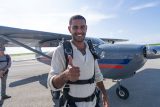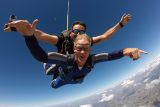3 Phases of Skydiving: What Happens After You Exit the Aircraft?
Skydiving
Posted by: Skydive Palm Beach
2 months ago
There are plenty of articles out about what to expect, what to wear, and how to prepare for your skydive – all of the stuff that happens before you board the plane. But what about once you’re actually in the air? What happens after the plane ride, when you exit the aircraft and enter into freefall? Skydive jumps are more than just falling from the sky – there are three distinct phases of skydiving:
- Freefall
- Parachute deployment
- Parachute descent and landing
Let’s explore what you can expect during the stages of skydiving and answer some frequently asked questions along the way.

Phase 1: Freefall
After you exit the aircraft, you’re officially in freefall, soaring through the sky at speeds of up to 120 mph! To keep things stable and help manage speed, your instructor will deploy a drogue shortly after exit. This small parachute slows you down just enough to stay within a safe and comfortable range, while still giving you that incredible rush.
How long do you freefall when you skydive?
You’ll be in freefall for around 40 seconds.
Does your freefall position matter?
While your instructor does most of the work, your body position helps with stability and control. You’ll be coached to arch your body — hips forward (they should be the lowest point), chin up, and feet back. Think of a banana shape. Your instructor will go over this with you on the ground before you board the plane, so no need to stress.
Can you breathe in freefall?
Yes, you can breathe in freefall. It might feel strange at first because of the adrenaline and wind speed, but many people who say they “can’t breathe” are actually just forgetting to breathe. Pro tip: if you feel like you can’t catch your breath, scream! Screaming forces you to exhale, which helps reset your breathing rhythm.
Phase 2: Parachute Deployment
When it’s time to end freefall, your instructor will deploy the main parachute, also known as a canopy. The drogue you deployed earlier helps with this process, making for a smooth transition.
The parachute is deployed at a certain altitude to ensure there’s enough time to respond to any issues and enjoy the breathtaking descent. Most canopy openings are pretty gentle, you typically feel a deceleration, not a jolt.
Do you fly up when the parachute deploys?
It might look like you’re going up in videos, but you’re not. It’s an illusion that occurs because the videographer in those videos continues freefalling while the tandem pair has slowed way down.
What if the skydiver’s parachute doesn’t work?
Skydiving systems are designed with multiple layers of redundancy. If the main parachute doesn’t deploy or function correctly, there is a reserve canopy. Tandem instructors are trained to recognize issues and follow specific emergency procedures to address them.
Tandem parachute rigs also include an Automatic Activation Device (AAD). This small computer monitors your speed and altitude during the skydive. If you are descending too quickly at a predetermined altitude, the AAD is designed to automatically deploy the reserve parachute.
While rare, malfunctions are something skydivers prepare for. Equipment is regularly inspected, and instructors train for these scenarios so they can respond appropriately.

Phase 3: Canopy Descent & Landing
While freefall is a high-speed adrenaline rush, the parachute ride down is often described as calm, quiet, and surreal. During canopy descent at Skydive Palm Beach, you’ll take in epic views of Lake Okeechobee, the Everglades, and everything in between.
How long are you in the air when skydiving under canopy?
Most canopy descents last about five to seven minutes. Descent speed can vary depending on several factors:
- Total combined weight of you and your instructor
- Wind and weather conditions
- Parachute type and how it’s flown
Your instructor will steer the parachute using toggles attached to the brake lines. Today’s modern parachutes are square-shaped and highly maneuverable, allowing instructors to navigate with impressive accuracy.
What about the skydive landing?
Before the jump, your instructor will train you on exactly what to do during the parachute landing. Most landings are soft, sit-down landings. Sometimes, if conditions are right, you may even get a stand-up landing! Either way, your instructor will give you clear instructions before and during the descent.
Final Thoughts
Skydiving is more than just a leap from a plane, it’s a carefully structured sequence of phases designed to give you the thrill of a lifetime. From the high-energy freefall to the calm float under canopy, every part of the jump is unique!
Questions before your skydive? Connect with us – we’re happy to walk you through it. Otherwise, book your jump and get ready for one of the most incredible experiences of your life. See you in the sky!




